Kenwood DDX5016DAB, DDX5016BTR, DDX5016BT User Manual
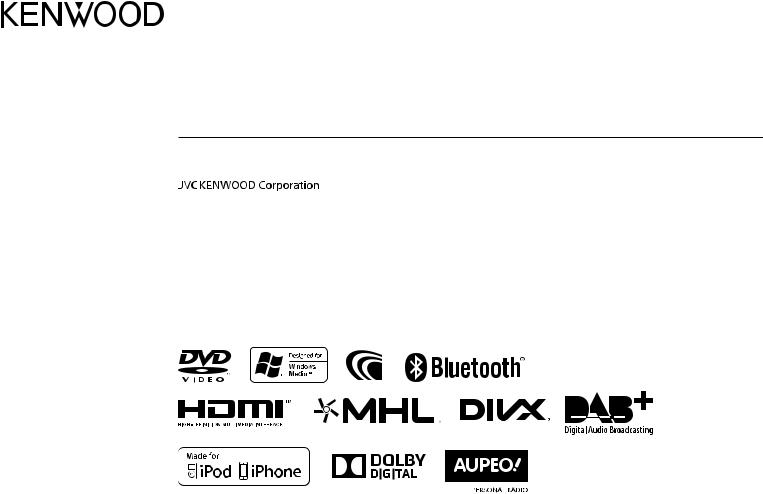
DDX5016DAB
DDX5016BT
DDX5016BTR
MONITOR WITH DVD RECEIVER
INSTRUCTION MANUAL
© 2016 JVC KENWOOD Corporation |
B5A-1059-00 (EN/QN) |

CONTENTS
BEFORE USE............................................................ |
2 |
How to reset your unit.................................................... |
3 |
INITIAL SETTINGS .................................................. |
4 |
Initial setup ......................................................................... |
4 |
Setting the security function ....................................... |
4 |
Clock settings .................................................................... |
5 |
BASICS .................................................................... |
6 |
Component names and functions ............................. |
6 |
Common operations ....................................................... |
7 |
Common screen operations......................................... |
8 |
Selecting the playback source..................................... |
9 |
DISCS .................................................................... |
11 |
USB........................................................................ |
16 |
iPod/iPhone ......................................................... |
18 |
APPs...................................................................... |
21 |
AUPEO! ................................................................. |
22 |
Radio..................................................................... |
24 |
DIGITAL RADIO (DAB) |
|
(Only for DDX5016DAB)...................................... |
27 |
OTHER EXTERNAL COMPONENTS ...................... |
32 |
Using external audio/video players—AV-IN ........ |
32 |
Using a rear view camera ............................................ |
32 |
Using a smartphone—HDMI/MHL........................... |
34 |
Watching a TV (Only for DDX5016DAB/ |
|
DDX5016BT) ..................................................................... |
34 |
Using the external navigation unit (Only for |
|
DDX5016DAB/DDX5016BT) ....................................... |
35 |
BLUETOOTH ......................................................... |
36 |
SETTINGS.............................................................. |
44 |
Settings for using applications of iPod/iPhone/ |
|
Android .............................................................................. |
44 |
Sound adjustment ......................................................... |
46 |
Adjustment for video playback................................. |
48 |
Changing the display design ..................................... |
50 |
Customizing the <HOME> screen............................ |
51 |
Customizing the system settings ............................. |
51 |
Setting menu items ....................................................... |
53 |
REMOTE CONTROLLER ........................................ |
56 |
CONNECTION/INSTALLATION ............................ |
59 |
REFERENCES......................................................... |
65 |
Maintenance .................................................................... |
65 |
More information ........................................................... |
65 |
Error message list ........................................................... |
69 |
Troubleshooting ............................................................. |
69 |
Specifications................................................................... |
71 |
BEFORE USE
IMPORTANT
To ensure proper use, please read through this manual before using this product. It is especially important that you read and observe WARNINGS and CAUTIONS in this manual. Please keep the manual in a safe and accessible place for future reference.
VWARNINGS: (To prevent accidents and damage)
•DO NOT install any unit or wire any cable in a location where;
–it may obstruct the steering wheel and gearshift lever operations.
–it may obstruct the operation of safety devices such as air bags.
–it may obstruct visibility.
•DO NOT operate the unit while driving.
If you need to operate the unit while driving, be sure to look around carefully.
•The driver must not watch the monitor while driving.
The marking of products using lasers
How to read this manual:
•Illustrations of DDX5016BT are mainly used for explanation. The displays and panels shown in this manual are examples used to provide clear explanations of the operations. For this reason, they may be different from the actual displays or panels.
•This manual mainly explains operations using the buttons on the monitor panel and touch panel. For operations using the remote controller (KNA-RCDV331: separately purchased), see page 56.
•< > indicates the various screens/menus/operations/settings that appear on the touch panel.
•[ ] indicates the buttons on the touch panel.
•Indication language: English indications are used for the purpose of explanation. You can select the indication language from the <Setup> menu. (Page 55)
•Updated information (the latest Instruction Manual, system updates, new functions, etc.) is available from <http://www.kenwood.com/cs/ce/>.
The label is attached to the chassis/case and says that the component uses laser beams that have been classified as Class 1. It means that the unit is utilizing laser beams that are of a weaker class. There is no danger of hazardous radiation outside the unit.
2
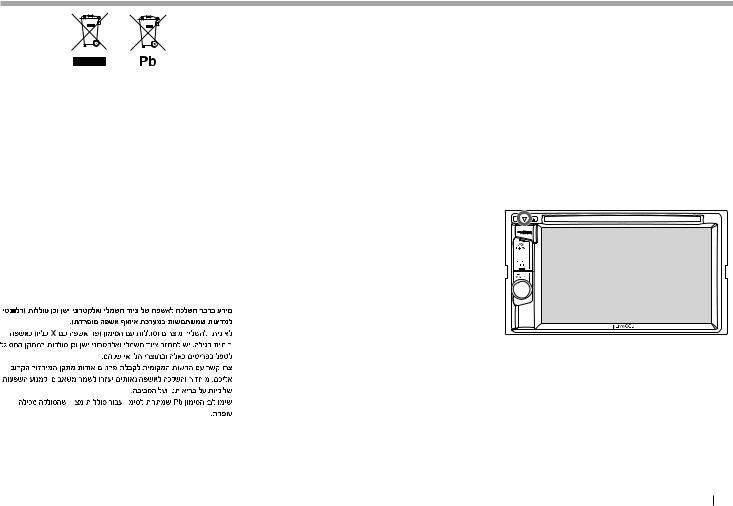
BEFORE USE
Information on Disposal of Old Electrical and Electronic Equipment and Batteries (applicable for countries that have adopted separate waste collection systems)
Products and batteries with the symbol (crossedout wheeled bin) cannot be disposed as household waste.
Old electrical and electronic equipment and batteries should be recycled at a facility capable of handling these items and their waste byproducts. Contact your local authority for details in locating a recycle facility nearest to you.
Proper recycling and waste disposal will help conserve resources whilst preventing detrimental effects on our health and the environment.
Notice: The sign “Pb” below the symbol for batteries indicates that this battery contains lead.
For Israel
VCautions on the monitor:
•The monitor built into this unit has been produced with high precision, but it may have some ineffective dots. This is inevitable and is not considered defective.
•Do not expose the monitor to direct sunlight.
•Do not operate the touch panel using a ball-point pen or similar tool with a sharp tip.
Touch the buttons on the touch panel with your finger directly (if you are wearing a glove, take it off).
•When the temperature is very cold or very hot...
–Chemical changes occur inside, causing malfunction.
–Pictures may not appear clearly or may move slowly. Pictures may not be synchronized with the sound or picture quality may decline in such environments.
For safety...
•Do not raise the volume level too much, as this will make driving dangerous by blocking outside sounds, and may cause hearing loss.
•Stop the car before performing any complicated operations.
Temperature inside the car...
If you have parked the car for a long time in hot or cold weather, wait until the temperature in the car becomes normal before operating the unit.
How to reset your unit
If the unit fails to operate properly, press the reset button.
ENGLISH 3
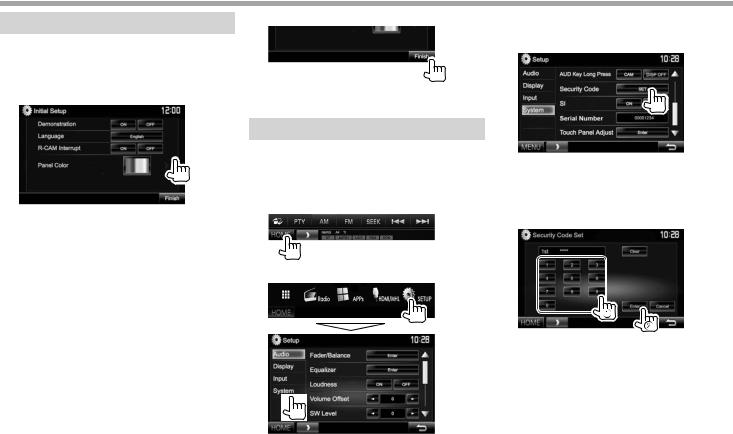
INITIAL SETTINGS
Initial setup
When you power on the unit for the first time or reset the unit, the initial setting screen appears.
•You can also change the settings on the <Setup> screen. (Page 53)
1 Perform the initial settings.
<Demonstration> |
Activate or deactivate the |
(Page 54) |
display demonstration. |
<Language> |
Select the text language |
(Page 55) |
used for on-screen |
|
information. |
|
• Set <GUI Language> |
|
to display the operation |
|
buttons and menu items |
|
in the selected language |
|
([Local]) or English. |
<R-CAM |
Select [ON] when |
Interrupt> |
connecting the rear view |
(Page 32) |
camera. |
<Panel Color> |
Select the color of the |
(Page 50) |
buttons on the monitor |
|
panel. |
2 Finish the procedure.
The <HOME> screen is displayed.
Setting the security function
Registering the security code
You can set a security code to protect your receiver system against theft.
1Display the <HOME> screen.
On the source control screen:
2Display the <System> setting screen.
3Display the <Security Code Set> screen.
•Press [K] repeatedly to change the page on the <System> menu screen.
•To clear the registered security code, perform steps 1 and 2, then press [CLR] in <Security Code>.
4Enter a four-digit number (1), then confirm the entry (2).
•Press [Clear] to delete the last entry.
•Press [Cancel] to cancel the setting.
5Repeat step 4 to confirm your security code.
Now, your security code is registered.
•When the unit is being reset or disconnected from the battery, you are required to enter the security code. Enter the correct security code, then press
[Enter].
4
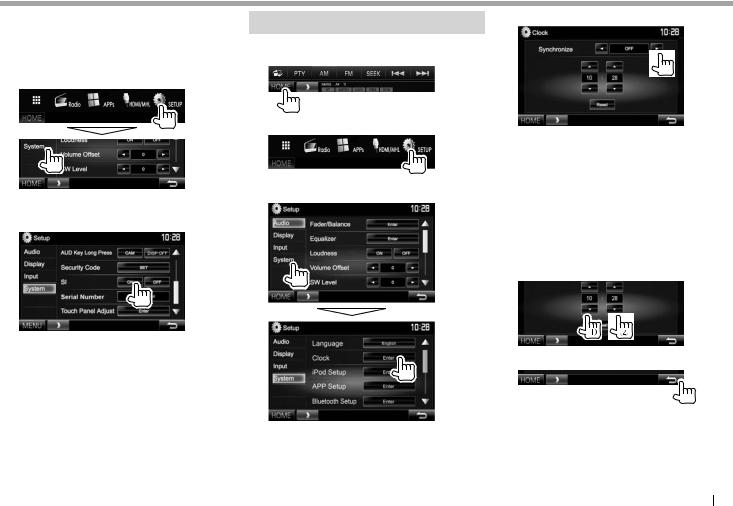
INITIAL SETTINGS
Activating the security function
You can activate the security function to protect your receiver system against theft.
1Display the <System> setting screen.
On the <HOME> screen:
•Press [K] repeatedly to change the page on the <System> menu screen.
2
The security indicator on the monitor panel flashes when the vehicle ignition is off.
To deactivate the security function: Select [OFF] for <SI>.
Clock settings
1Display the <HOME> screen.
On the source control screen:
2Display the <Setup> screen.
3Display the <Clock> screen.
4 Set the clock time.
<Radio Data |
Synchronizes the clock time with |
System>*2 |
FM Radio Data System. |
<DAB>*3 |
Synchronizes the clock time with |
|
the digital radio (DAB). |
<NAV>*1 |
Synchronizes the clock time with |
<OFF> |
the connected navigation unit. |
Sets the clock manually. (See |
|
|
below.) |
When selecting <OFF>:
Adjust the hour (1), then adjust the minute (2).
• Press [Reset] to set the minute to “00”.
5 Finish the procedure.
*1 Only for DDX5016DAB/DDX5016BT: Appears only when the navigation unit is connected.
*2 Only for DDX5016BT/DDX5016BTR. *3 Only for DDX5016DAB.
ENGLISH 5
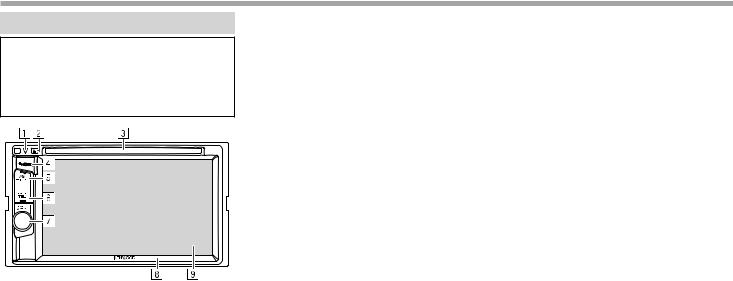
BASICS
Component names and functions
VCaution on the volume setting:
Digital devices produce very little noise compared with other sources. Lower the volume before playing these digital sources to avoid damaging the speakers by sudden increase of the output level.
1Reset button/Power indicator/Security indicator
•Resets the unit. (Page 3)
•Lights up while the unit is turned on.
•Flashes when the security function is activated. (Page 5)
2M(Eject) button
Ejects the disc. (Page 11)
3Loading slot
4BHOME button
•Displays the <HOME> screen. (Press) (Page 8)
•Turns on the power. (Press) (Page 7)
•Turns off the power. (Hold) (Page 7)
5AV/DISP OFF button
•Displays the current source screen. (Press)
•The function of the button when held varies depending on the <AV Key Long Press> setting. (Page 55)
6TEL/VOICE button
•Displays the phone control screen. (Press) (Page 40)
•Activates voice dialing. (Hold) (Page 41)
7Volume/ATT/APPS knob
•Displays the App screen. (Press) (Page 21)
•Attenuates the sound. (Hold) (Page 7)
•Adjusts the audio volume. (Turn) (Page 7)
8Monitor panel*
9Screen (touch panel)
*You can change the color of the buttons on the monitor panel. (Page 50)
6
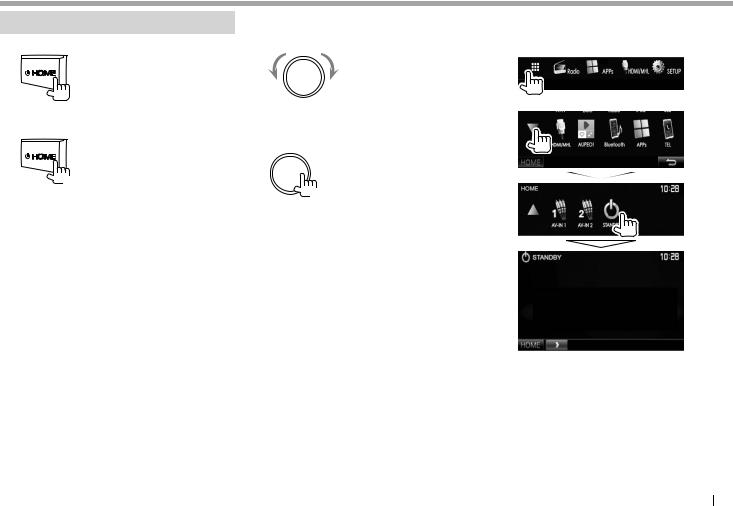
BASICS
Common operations
Turning on the power
Turning off the power
(Hold)
Adjusting the volume |
Putting the unit in standby |
To adjust the volume (0 to 35) |
1 Display the <HOME> screen. |
|
On the <HOME> screen: |
Turn to the right to increase, and turn to the left to |
2 |
decrease. |
|
To attenuate the sound |
|
(Hold) |
|
The ATT indicator lights up. |
|
To cancel the attenuation: Press and hold ATT |
|
again. |
|
ENGLISH 7
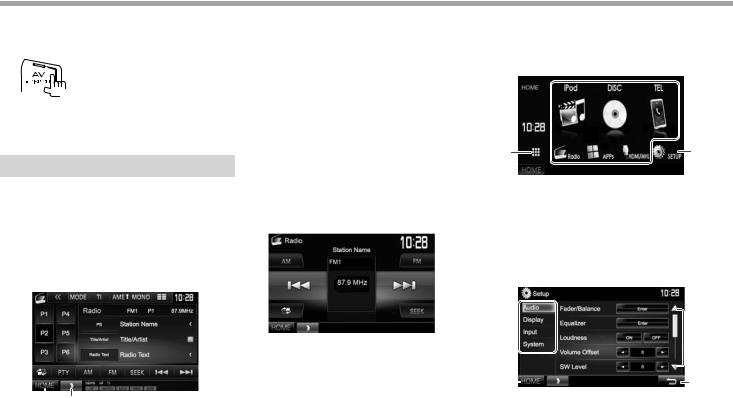
BASICS
Turning off the screen
•This operation works only when <AV Key Long Press> is set to [DISP OFF]. (Page 55)
(Hold)
To turn on the screen: Press and hold the same button, or touch the display.
Common screen operations
Common screen descriptions
You can display other screens any time to change the source, show the information, or change the settings, etc.
Source control screen
Performs source playback operations.
•The operation buttons and information displayed vary depending on the selected source.
1
2
3 4
Common operation buttons:
1Displays other operation buttons.
•Disabled when there are no other buttons.
2Switches between the normal source control screen and easy control screen. (See below.)
3Displays the <HOME> screen. (See the right column.)
•Pressing BHOME on the monitor panel also displays the <HOME> screen.
4Displays/hides short-cut buttons. (Page 10)
Easy control screen
Pressing [ ] switches between the normal source control screen and easy control screen.
] switches between the normal source control screen and easy control screen.
The easy control screen allows you to control the source easily with simple buttons.
•The buttons displayed vary depending on the selected source.
<HOME> screen
Displays the source control screen and settings screen.
•You can arrange the items to display on the <HOME> screen.(Page 51)
1
2 |
3 |
Common operating buttons:
1Changes the playback source. (Page 10)
2Displays all playback sources and items. (Page 9)
3Displays the <Setup> screen. (See below.)
<Setup> screen
Changes the detailed settings. (Page 53)
1
 3
3
2 |
4 |
Common operating buttons:
1Selects the menu category.
2Displays the <HOME> screen.
3Changes the page.
4Returns to the previous screen.
8
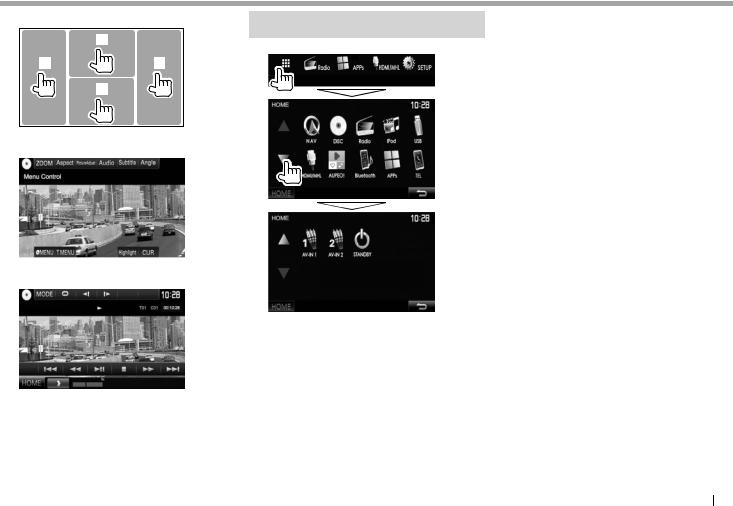
BASICS
Touch screen operations
1
3 4
2
1Displays the video control menu while playing a video.
2Displays the source control screen while playing a video.
• The operation buttons disappear when the screen is touched or when no operation is done for about 5 seconds.
3Goes to the previous chapter/track.*
4Goes to the next chapter/track.*
* Not available for video from an external component.
Selecting the playback source
On the <HOME> screen:
•You can change the page to display more items by pressing [J]/[K].
Displays the navigation screen when a navigation unit is connected. (Page 35)
Plays a disc. (Page 11)
Switches to the radio broadcast. (Page 24)
Switches to the digital audio broadcast (DAB). (Page 27) Plays an iPod/iPhone. (Page 18) Plays files on a USB device. (Page 16)
Plays a device connected to the HDMI/MHL input terminal. (Page 34)
Switches to the AUPEO! application. (Page 22)
Plays a Bluetooth audio player. (Page 42)
Switches to the App screen from the connected iPod touch/iPhone/ Android device. (Page 21)
Displays the phone control screen. (Page 40)
[AV-IN1][AV-IN2]
Switches to an external component connected to the AV-IN1 or iPod/AV-IN2 input terminal. (Page 32)
*1 Only for DDX5016DAB/DDX5016BT: When no navigation unit is connected, “No Navigation” appears.
*2 Only for DDX5016DAB.
ENGLISH 9
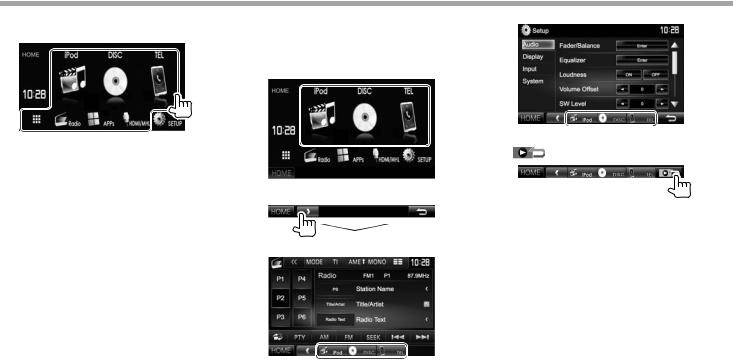
BASICS
Selecting the playback source on the |
Using short-cut buttons |
On the <Setup> screen: |
<HOME> screen |
While displaying the source control screen or the |
|
|
<Setup> screen, you can use the short-cut buttons |
|
|
to go to the items on the <HOME> screen indicated |
|
|
below. |
|
• You can change the items (other than [SETUP]) to |
• When the navigation screen is displayed, pressing |
||
[ |
] displays the source control screen.* |
||
display on the <HOME> screen. (Page 51) |
|||
|
|
||
To display the short-cut buttons
To hide the short-cut buttons: Press [  ].
].
* Only for DDX5016DAB/DDX5016BT.
On the source control screen:
10

DISCS
Playing a disc
•If a disc does not have a disc menu, all tracks on it will be played repeatedly until you change the source or eject the disc.
•For playable disc types/file types, see page 66.
Inserting a disc
Insert a disc with the label side facing up.
The source changes to “DISC” and playback starts.
• The IN indicator lights up while a disc is inserted.
•If “ ” appears on the screen, the unit cannot accept the operation you have tried to do.
” appears on the screen, the unit cannot accept the operation you have tried to do.
–In some cases, without showing “ ,” operations will not be accepted.
,” operations will not be accepted.
•When playing back a multi-channel encoded disc, the multi-channel signals are downmixed to stereo.
Ejecting a disc
•When removing a disc, pull it horizontally.
•You can eject a disc when playing another AV source.
•If the ejected disc is not removed within
60 seconds, the disc is automatically inserted again into the loading slot to protect it from dust.
Playback operations
When the operation buttons are not displayed on the screen, touch the area shown on the illustration.
•To change settings for video playback, see page 48.
Indications and buttons on the source control screen
For video playback
1 |
2 |
3 |
4 5 6
Playback information
•The information displayed on the screen differs depending on the type of disc/file being played back.
1Media type
2Current playback item information (title no./ chapter no./folder no./file no./track no.)
3Playing time
4Playback mode (Page 14)
5File type
6IN indicator
Continued on the next page...
ENGLISH 11
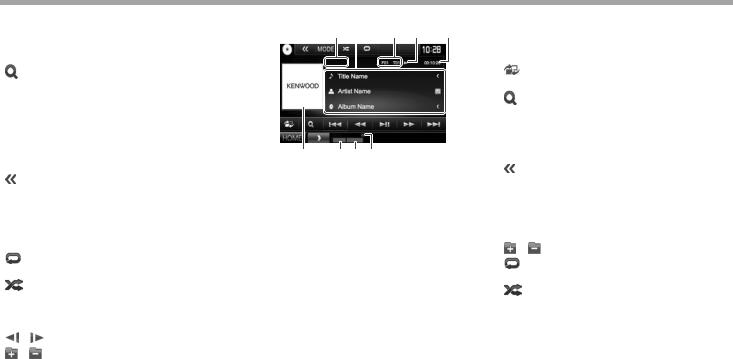
DISCS
Operation buttons
•Available buttons on the screen and operations differ depending on the type of disc/file being played back.
[ |
] |
|
Displays the folder/track list. |
[O] [N] |
(Page 13) |
||
Reverse/forward search during |
|||
[S] [T] |
playback. |
||
• Selects a chapter/track. (Press) |
|||
[IW] |
|
• Reverse/forward search. (Hold) |
|
|
Starts/pauses playback. |
||
[o] |
|
|
Stops playback. |
[ |
] |
|
Displays other operation buttons. |
|
|
|
• Disabled when there are no other |
[MODE] |
|
buttons. |
|
|
Changes the settings for disc |
||
|
|
|
playback on the <DISC Mode> |
|
|
|
screen. (Page 15) |
[ |
] |
|
Selects Repeat playback mode. |
[ |
] |
|
(Page 14) |
|
Selects Random playback mode. |
||
[Playlist] |
|
(Page 14) |
|
|
Displays the Original Program/ |
||
|
|
|
Playlist screen. |
[ |
] [ |
] |
Plays in frame-by-frame. |
[ |
] [ |
] |
Selects a folder. |
[PBC] |
|
Activates or deactivates the VCD PBC |
|
|
|
|
(Playback Control) function. |
[HOME] |
|
Displays the <HOME> screen. |
|
For audio playback
1 2 3 4 5
6 7 8 9
Playback information
•The information displayed on the screen differs depending on the type of disc/file being played back.
1Media type
2Track/file information
•Pressing [<] scrolls the text if not all of the text is shown.
3Current playback item information (folder no./file no./track no.)
4Playback status
5Playing time
6Jacket picture (Shown while playing if the file has tag data that includes the jacket picture)
7Playback mode (Page 14)
8File type
9IN indicator
Operation buttons
•Available buttons on the screen and operations differ depending on the type of disc/file being played back.
[ |
] |
Displays the easy control screen. |
|
|
(Page 8) |
[ |
] |
Displays the folder/track list. |
[S] [T] |
(Page 13) |
|
Selects a track. |
||
[O] [N] |
Reverse/forward search. |
|
[IW] |
Starts/pauses playback. |
|
[ |
] |
Displays other operation buttons. |
|
|
• Disabled when there are no other |
[MODE] |
buttons. |
|
Changes the settings for disc |
||
|
|
playback on the <DISC Mode> |
|
|
screen. (Page 15) |
[ |
] [ ] |
Selects a folder. |
[ |
] |
Selects Repeat playback mode. |
[ |
] |
(Page 14) |
Selects Random playback mode. |
||
[o] |
|
(Page 14) |
|
Stops playback. |
|
[HOME] |
Displays the <HOME> screen. |
|
12
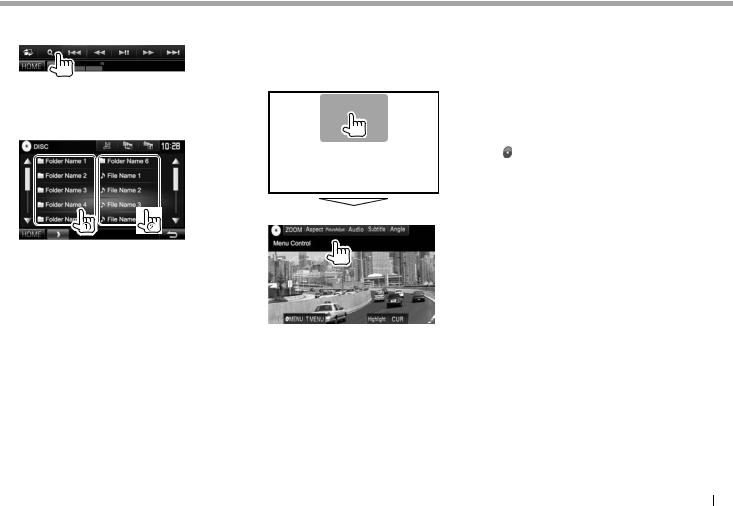
DISCS
Selecting a folder/track on the list
1Display the folder/track list.
2Select the folder (1), then the item in the selected folder (2).
•Repeat the procedure until you select the desired track.
•You can change the page to display more items by pressing [J]/[K].
•Press [  ] to open the folder containing the current track.
] to open the folder containing the current track.
•Press [  ] to return to the root folder.
] to return to the root folder.
•Press [  ] to return to the upper layer.
] to return to the upper layer.
Video menu operations
You can display the video menu screen during video playback.
•The operation buttons disappear when the screen is touched or when no operation is done for about 5 seconds.
For video playback except VCD
•Available buttons on the screen and operations differ depending on the type of disc/file being played back.
[ZOOM] |
Displays the picture size selection |
[Aspect] |
screen. (Page 49) |
Selects the aspect ratio. |
|
[PictureAdjust] |
(Page 49) |
Displays the picture adjustment |
|
[Audio] |
screen. (Page 48) |
Selects the audio type (or channel |
|
[Subtitle] |
for DVD-VR). |
Selects the subtitle type. |
|
[Angle] |
Selects the view angle. |
[ MENU] |
Displays the disc menu. |
[T MENU] |
Displays the disc menu (DVD). |
[Highlight] |
Switches to the direct disc menu |
|
mode. Touch the target item to |
|
select. |
|
• To exit the menu selection |
|
screen, press AV/DSP OFF on |
[CUR] |
the monitor panel. |
Displays the menu/scene |
|
|
selection screen. |
|
• [J] [K] [H] [I]: Selects an item. |
|
• [Enter]: Confirms the selection. |
|
• [Return]: Returns to the |
|
previous screen. |
Continued on the next page...
ENGLISH 13
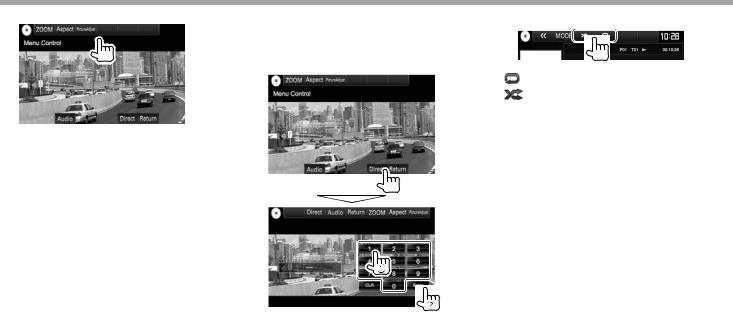
DISCS
For VCD |
To select a track directly on a VCD |
|
While playing a VCD with PBC activated... |
|
• When PBC is deactivated, activate the PBC |
|
function by pressing [PBC] on the source control |
|
screen. |
[ZOOM] |
Displays the picture size selection |
[Aspect] |
screen. (Page 49) |
Selects the aspect ratio. |
|
[PictureAdjust] |
(Page 49) |
Displays the picture adjustment |
|
[Audio] |
screen. (Page 48) |
Selects the audio channel (ST: |
|
[Direct] |
stereo, LL: left, RR: right). |
Displays/hides the direct selection |
|
[Return] |
buttons. (See the right column.) |
Displays the previous screen or |
|
|
menu. |
• When you enter a wrong number, press [CLR] to delete the last entry.
Selecting playback mode
[ |
] |
Selects Repeat playback mode. |
[ |
] |
Selects Random playback mode. |
•Available playback modes differ depending on the type of disc/file being played back.
•You cannot activate the repeat mode and the random mode at the same time.
•Each time you press the button, the playback mode changes. (The corresponding indicator lights up.)
–Available items differ depending on the type of disc/file being played back.
C-REP |
Repeats current chapter. |
T-REP |
Repeats current title/program. |
REP |
Repeats current track. |
FO-REP |
Repeats all tracks of the |
FO-RDM |
current folder. |
Randomly plays all tracks of |
|
|
the current folder, then tracks |
RDM |
of the next folders. |
Randomly plays all tracks. |
To cancel Repeat/Random playback: Press the button repeatedly until the indicator disappears.
14

DISCS
Settings for disc playback
•Available items shown on the <DISC Mode> screen differ depending on the type of disc/file being played back.
Setting items
<Menu |
Select the initial disc menu language. |
Language>* |
(Initial: English) (Page 68) |
<Subtitle |
Select the initial subtitle language |
Language>* |
or turn subtitles off (Off). (Initial: |
|
English) (Page 68) |
<Audio |
Select the initial audio language. |
Language>* |
(Initial: Original) (Page 68) |
<Dynamic |
You can change the dynamic range |
Range |
while playing using Dolby Digital |
Control>* |
software. |
|
• Wide: Select this to enjoy a |
|
powerful sound at a low volume |
|
level with its full dynamic range. |
|
• Normal: Select this to reduce the |
|
dynamic range a little. |
|
• Dialog (Initial): Select this to |
|
reproduce movie dialog more |
|
clearly. |
<Angle |
Select whether to display the angle |
|
Mark> |
mark. |
|
|
• ON (Initial): Select this to display |
|
|
the angle mark. |
|
|
• OFF: Select this to hide the angle |
|
|
mark. |
|
<Screen |
Select the monitor type to watch a |
|
Ratio>* |
wide screen picture on the external |
|
|
monitor. |
|
|
16:9 (Initial) 4:3 LB |
4:3 PS |
<Parental |
Set the parental level. |
|
Level>* |
(See the right column.) |
|
<CD Read> |
Select the files to play on a disc |
|
|
containing music files. You cannot |
|
|
change the setting when a disc is |
|
|
inserted. |
|
•1 (Initial): Automatically distinguishes between audio file discs and music CDs.
•2: Forces playback as a music CD. No sound can be heard if an audio file disc is played.
*You can change these settings only while playback is stopped.
Setting the parental lock
The parental lock cannot be set during DVD playback.
1Display the <Parental Pass> screen.
On the <DISC Mode> screen:
•Press [K] repeatedly to change the page on the <DISC Mode> screen.
2Enter the 4-digit parental pass code (1), and press [Enter] (2).
•To clear the entry, press [Clear].
•To cancel setting the code, press [Cancel].
3Adjust the parental level (<OFF>, <Level 1> to <Level 8>).
To deactivate the parental lock: Select <OFF> for <Parental Level>.
ENGLISH 15
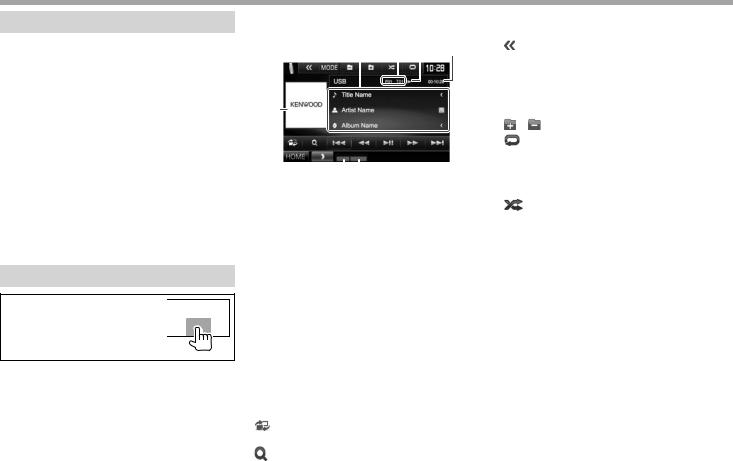
USB
Connecting a USB device
You can connect a USB mass storage class device such as a USB memory, Digital Audio Player etc. to the unit.
•For details about connecting USB devices, see page 62.
•You cannot connect a computer or portable HDD to the USB input terminal.
•For playable file types and notes on using USB devices, see page 67.
When a USB device is connected...
The source changes to “USB” and playback starts.
•All tracks in the USB device will be played repeatedly until you change the source.
To disconnect the USB device safely:
Press [M], then disconnect the USB device after “No Device” appears.
Playback operations
When the operation buttons are not displayed on the screen, touch the area shown on the illustration.
•To change settings for video playback, see page 48.
Indications and buttons on the source control screen
1 2 3 4
5 |
6 7 |
Playback information
•The information displayed on the screen differs depending on the type of file being played back.
1Track/file information
•Pressing [<] scrolls the text if not all of the text is shown.
2Current playback item information (folder no./file no.)
3Playback status
4Playing time
5Jacket picture (Shown while playing if the file has tag data that includes the jacket picture)
6Playback mode (See the right column.)
7File type
Operation buttons
•Available buttons on the screen and operations differ depending on the type of file being played back.
[ |
] |
Displays the easy control screen. |
|
|
(Page 8) |
[ |
] |
Displays the list selection screen. |
|
|
(Page 17) |
[S] [T] Selects a track.
[O] [N] |
Reverse/forward search. |
|
[IW] |
Starts/pauses playback. |
|
[ |
] |
Displays other operation buttons. |
|
|
• Disabled when there are no other |
[MODE] |
buttons. |
|
Changes the settings for USB |
||
|
|
playback on the <USB Mode> screen. |
|
|
(Page 17) |
[ |
] [ ] |
Selects a folder. |
[ |
] |
Selects repeat playback mode.*1 *2 |
|
|
• REP: Repeats the current track/file. |
|
|
• FO-REP: Repeats all tracks/files |
|
|
in the current folder or specified |
[ |
] |
category. |
Selects random playback mode. (The |
||
|
|
RDM indicator lights up.)*1 *2 |
|
|
• When selecting the track/file from |
|
|
a folder, randomly plays all tracks/ |
|
|
files of the current folder, then the |
|
|
tracks/files of the next folder. |
|
|
• When selecting the track/file from a |
|
|
category, randomly plays all tracks/ |
[M] |
|
files of the specified category. |
|
Disconnects the USB device safely. |
|
[HOME] |
Displays the <HOME> screen. |
|
*1 To cancel random or repeat mode, press the button repeatedly until the indicator disappears.
*2 You cannot activate the repeat mode and the random mode at the same time.
16
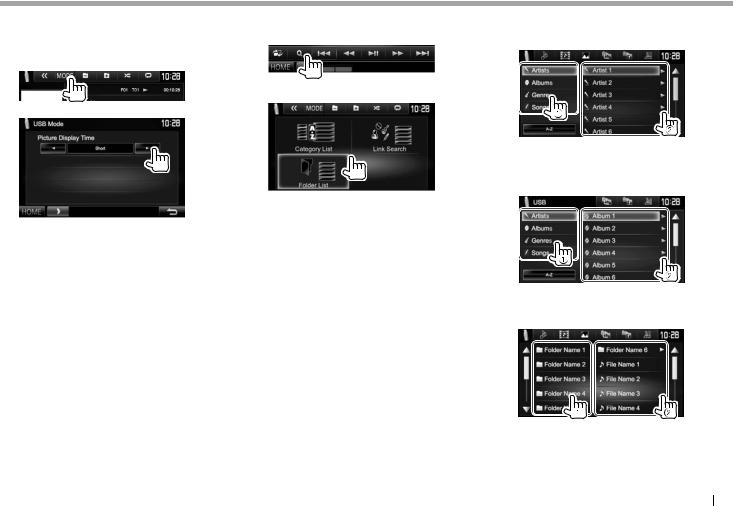
USB
Setting picture display time
Select the interval between slides during slide-shows of the picture files.
1 Display the <USB Mode> screen.
Selecting a track in a list
1 Display the list selection screen.
2
2
3
Select the list type.
Select the track.
•You can change the page to display more items by pressing [J]/[K].
•Press [  ] to return to the root folder.
] to return to the root folder.
•Press [  ] to return to the upper layer.
] to return to the upper layer.
•Press [  ] to open the folder containing the current track.
] to open the folder containing the current track.
•If you want to play all tracks in the folder, press [I] on the right of the desired folder.
•On the <Category List>/<Folder List>: You
can switch the file type to list: Press [  ] to list audio files, [
] to list audio files, [  ] to list video files, or [
] to list video files, or [  ] to list still picture files.
] to list still picture files.
•On the <Category List>/<Link Search>: To list the items in alphabetical order, press [A-Z], then select the first character.
From <Category List>:
Select the category (1), then the item in the selected category (2).
From <Link Search>:
Select the tag type (1) to display a list of content that contains the same tag as the track/ file currently being played, then the item (2).
From <Folder List>:
Select the folder (1), then the item in the selected folder (2).
ENGLISH 17
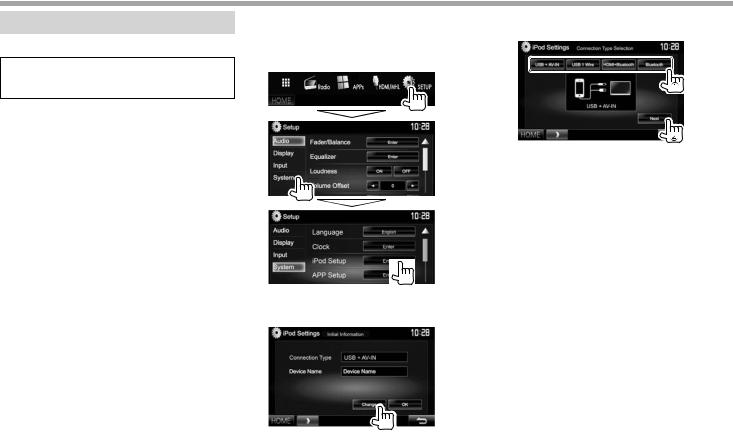
iPod/iPhone
Preparation
Connecting iPod/iPhone
•For details about connecting iPod/iPhone, see page 62.
•For playable iPod/iPhone types, see page 67.
Connect your iPod/iPhone according to your purpose or the type of iPod/iPhone.
Wired connection
•To listen to music:
–For Lightning connector models: Use USB Audio cable for iPod/iPhone—KCA-iP103 (optional accessory).
–For 30-pin connector models: Use USB Audio cable for iPod/iPhone—KCA-iP102 (optional accessory).
•To watch video and listen to music:
–For Lightning connector models: Use the HDMI cable KCA-HD100 (optional accessory) and KCA-iP103 (optional accessory) through a Lightning-Digital AV adapter (accessory of the iPod/iPhone).
–For 30-pin connector models: Use USB Audio and Video cable for iPod/iPhone—KCA-iP202 (optional accessory).
Bluetooth connection
Pair the iPod/iPhone through Bluetooth. (Page 36)
•For Lightning connector models: To watch video, connect your iPod/iPhone to the HDMI/MHL input terminal using KCA-HD100 (optional accessory). (Page 63)
•For 30-pin connector models: You cannot watch video with a Bluetooth connection.
Selecting the iPod/iPhone device to |
3 Select the connection method (1), then |
play and connection method |
press [Next] (2). |
1 Display the <iPod Settings> screen. |
|
On the <HOME> screen: |
|
<USB + |
Select this when the iPod/ |
AV-IN> |
iPhone is connected using |
|
KCA-iP202 (optional accessory). |
•If [Enter] for <iPod Setup> cannot be selected, put the unit in standby. (Page 7)
2
<USB 1 Wire> Select this when the iPod/ iPhone is connected using KCA-iP102 (optional accessory) or KCA-iP103 (optional accessory).
<HDMI + Select this when the iPod/ Bluetooth> iPhone is connected using
HDMI cable KCA-HD100 (optional accessory) and KCA-iP103 (optional accessory) through a Lightning-Digital AV adapter (accessory of the iPod/ iPhone).
<Bluetooth> Select this when the iPod/ iPhone is connected via Bluetooth.
• When selecting <USB + AV-IN> or <USB 1 Wire>, go to step 5.
•If you do not need to change the settings, press [OK] to exit the setup screen.
18
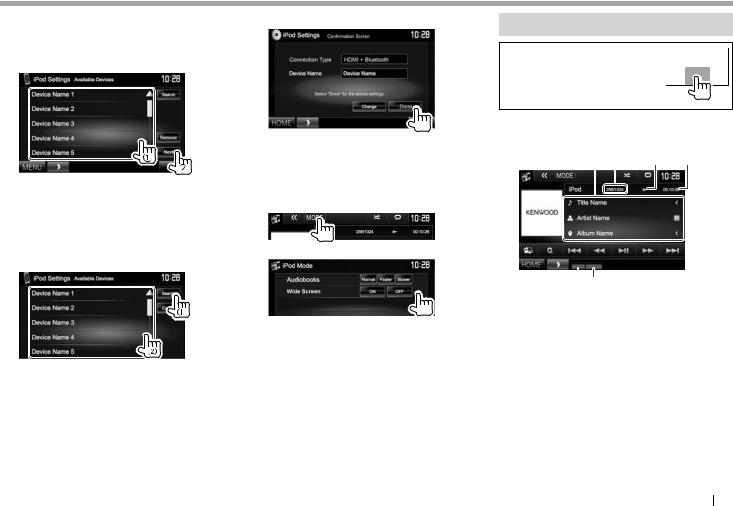
iPod/iPhone
4 When selecting <HDMI + Bluetooth> or |
5 Confirm the settings. |
<Bluetooth> as the connection method, |
|
the paired device list appears. Select the |
|
target device (1), then press [Next] (2). |
|
•You can delete the Bluetooth registration of a device. Press [Remove], then press [Yes] after a confirmation message appears.
•If the desired device is not listed, press [Search] to search for the available iPod/ iPhone (1), then select the target device from the <Available Devices> screen (2).
–You can change the page to display more items by pressing [J]/[K].
–To stop searching, press [Cancel].
Selecting preference settings for iPod/ iPhone playback
When the source is “iPod”...
1 Display the <iPod Mode> screen.
2
<Audiobooks> Select the speed of audio books.
<Wide |
• [ON]: Select this to display |
Screen>* |
video compatible with |
|
wide-screen display in wide- |
|
screen. |
•[OFF]: Select this to deactivate.
*You cannot change the setting when iPod/iPhone is connected.
Playback operations
When the operation buttons are not displayed on the screen, touch the area shown on the illustration.
•To change settings for video playback, see page 48.
Indications and buttons on the source control screen
1 2 3 4
5
6 7
Playback information
1Song information
•Pressing [<] scrolls the text if not all of the text is shown.
2Track no./Total track number
3Playback status
4Playing time
5Artwork (Shown if the song contains artwork)
6Playback mode (Page 20)
7File type
Continued on the next page...
ENGLISH 19
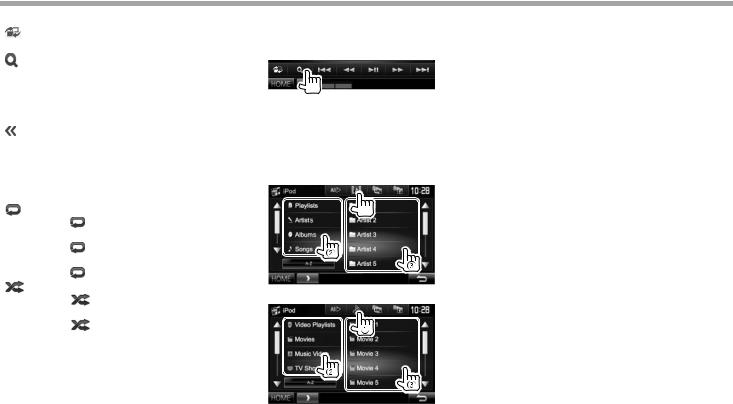
iPod/iPhone
Operation buttons
[ ] Displays the easy control screen. (Page 8)
[ |
] |
Displays the audio/video track menu. |
|
|
|
(See the right column.) |
|
[S] [T] Selects a track. |
|||
[O] [N] |
Reverse/forward search. |
||
[IW] |
Starts/pauses playback. |
||
[ |
] |
Displays other operation buttons. |
|
|
|
• Disabled when there are no other |
|
[MODE] |
|
buttons. |
|
Changes the settings for iPod/iPhone |
|||
|
|
playback on the <iPod Mode> screen. |
|
|
|
(Page 19) |
|
[ |
] |
Selects repeat playback mode. |
|
|
|
• |
1: Functions the same as Repeat |
|
|
|
One. |
|
|
• |
All: Functions the same as |
|
|
• |
Repeat All. |
[ |
] |
: Cancels the repeat mode. |
|
Selects random playback mode.* |
|||
|
|
• |
: Functions the same as Shuffle |
|
|
|
Songs. |
|
|
• |
Album: Functions the same as |
|
|
|
Shuffle Albums. |
[HOME] |
Displays the <HOME> screen. |
||
*To cancel random mode, press the button repeatedly until the indicator disappears.
Selecting an audio/video track from the menu
1Display the menu screen.
2Select the menu ( : audio or
: audio or  : video) (1), a category (2), then a desired item (3).
: video) (1), a category (2), then a desired item (3).
•Select an item in each layer until you reach and select the desired track.
Audio menu:
Video menu:
•You can change the page to display more items by pressing [J]/[K].
•Press [All E] to play all songs/videos.
•Press [A-Z] to sort the list in alphabetical order.
–You cannot sort the list in alphabetical order on the Playlists.
•Press [  ] to return to the top layer.
] to return to the top layer.
•Press [  ] to return to the upper layer.
] to return to the upper layer.
•Available categories differ depending on the type of your iPod/iPhone.
20
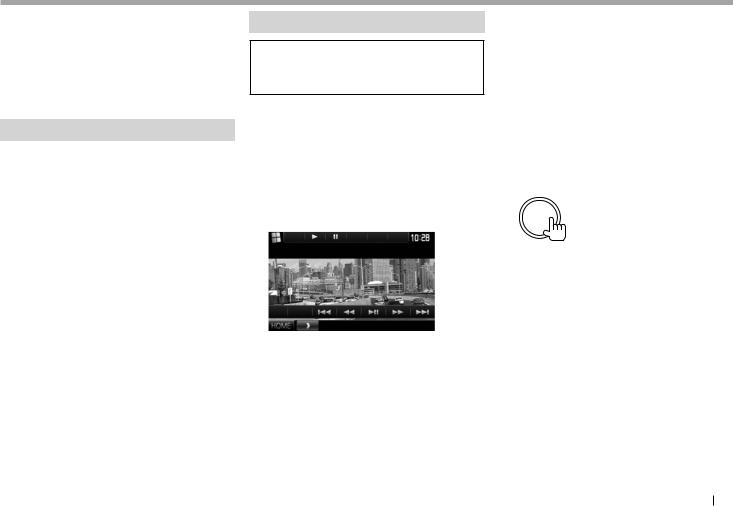
APPs
You can use an App of the connected iPod touch/ iPhone/Android on this unit.
•For Apps you can use on this unit, visit <http://www.kenwood.com/cs/ce>.
•For Android devices, you can use more functions with the KENWOOD Smartphone Control application. For details, visit <http://www.kenwood.com/cs/ce>.
Preparation
1Connect the iPod touch/iPhone/Android.
•For wired connection, see page 62 for iPod touch/iPhone or page 63 for Android.
–To view video, connect the device using KCA-iP202 or KCA-HD100 (optional accessory).
•For Bluetooth connection, see page 36.
2Select the iPod touch/iPhone/Android device to use and connection method on the <APP Settings> screen. (Page 44)
Using an App
When the operation buttons are not displayed on the screen, touch the screen to show them.
•To change settings for video playback, see page 48.
Playback operations
1Start the App on your iPod touch/iPhone/ Android.
2Select “APPs” as the source. (Page 9)
•When a caution message is displayed, operate by following the message.
Operation buttons on the source control screen
•You can operate some functions of the App on the touch panel.
•For some applications such as navigation applications, the operation buttons and information are not shown. You can perform the operations on the touch panel, such as scrolling the map.
–If “ ” appears on the screen, the unit cannot accept the touch operation you have tried to do.
” appears on the screen, the unit cannot accept the touch operation you have tried to do.
•You can also play back the audio/video using iPod/iPhone/Android itself instead of the unit.
Switching to the App screen while listening to another source
To return to the source control screen: Press the same button again.
[I] |
Starts playback. |
[W] |
Pauses playback. |
[S] [T] Selects an audio/video file. |
|
[O] [N] |
Reverse/forward search. |
[IW] |
Starts/pauses playback. |
[HOME] |
Displays the <HOME> screen. |
ENGLISH 21

AUPEO!
AUPEO! Personal Radio plays free music you really like. You can develop your own personalized Internet radio by rating or skipping tracks.
You can stream AUPEO! from connected iPod touch/iPhone or Android devices.
•Install the latest version of the AUPEO! application on your iPod touch/iPhone/Android and create an account.
Preparation
1Connect the device.
•For Android: Pair the Android device through Bluetooth. (Page 36)
•For iPod touch/iPhone: Connect iPod touch/ iPhone. (Page 18)
2Select the device to use and connection method on the <APP Settings> screen. (Page 44)
3Select “AUPEO!” as the source. (Page 9)
The AUPEO! application is started.
Playback operations
You can operate AUPEO! using the remote controller*. Only playing, pausing, and skipping are available.
Indications and buttons on the source control screen
1 |
2 |
3 |
Playback information
1Picture data
2Track information
•Pressing [<] scrolls the text if not all of the text is shown.
3Playback status
Operation buttons
[ ] Displays the easy control screen. (Page 8)
[ |
] |
Displays the <Station Search> |
|
|
screen. (Page 23) |
[ |
] |
“Loves” and registers the current |
[IW] |
track as a favorite. |
|
Starts/pauses playback. |
||
[T] |
Skips the current track. |
|
[ |
] |
“Bans” the current track and skips to |
|
|
the next track. |
[HOME] |
Displays the <HOME> screen. |
|
* Purchase KNA-RCDV331 separately.
22
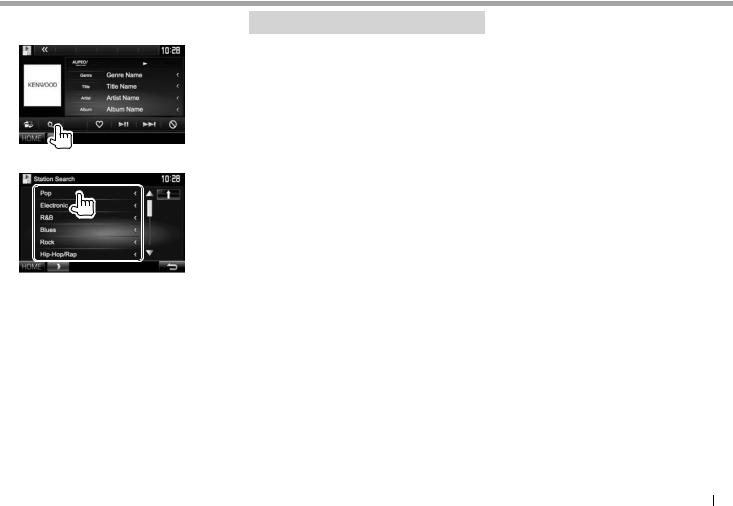
AUPEO!
Selecting a station
1 Display the <Station Search> screen.
2 Select the category, then the station.
• To return to the previous layer, press [  ] .
] .
Requirements for AUPEO!
iPhone or iPod touch
•Install the latest version of the AUPEO! application on your iPhone or iPod touch. (Search for “AUPEO!” in the Apple iTunes App Store to find and install the most recent version.)
•Connect iPod touch/iPhone to this unit with a cable or via Bluetooth.
–When connecting with a cable: Use KCA-iP202, KCA-HD100, KCA-iP102 (optional accessory) or KCA-iP103 (optional accessory).
–When connecting via Bluetooth, the following profiles must be supported.
–SPP (Serial Port Profile)
–A2DP (Advanced Audio Distribution Profile)
Android™
•Visit Google play and search for “AUPEO!” to install.
•Bluetooth must be built in and the following profiles must be supported.
–SPP (Serial Port Profile)
–A2DP (Advanced Audio Distribution Profile)
NOTE
•Ensure you are logged in to your smartphone application. If you do not have an AUPEO! account, you can create one for free from your smartphone or at www.aupeo.com.
•Because AUPEO! is a third-party service, the specifications are subject to change without prior notice. Accordingly, compatibility may be impaired or some or all of the services may become unavailable.
•Some functions of AUPEO! cannot be operated from this unit.
•For issues using the application, contact AUPEO! at www.aupeo.com.
•Establish an Internet connection using LTE, 3G, EDGE, or WiFi.
ENGLISH 23

Radio
Listening to the radio
Indications and buttons on the source control screen
1 |
2 |
3 |
 p
p
q
4567 8 9
Radio reception information
1Band
2Preset no.
3The station frequency currently tuned in
4ST/MONO indicator
•The ST indicator lights up when receiving an FM stereo broadcast with sufficient signal strength.
5AF indicator (Page 26)
6Seek mode (See the right column.)
7LO.S indicator (See the far right column.)
8RDS indicator: Lights up when receiving a Radio Data System station.
9EON indicator: Lights up when a Radio Data System station is sending EON signals.
pText information
•Pressing [<] scrolls the text if not all of the text is shown.
•Pressing [Radio Text] switches the information between Radio Text, Radio Text Plus, and PTY code.
qStandby reception indicators (Page 25)
Operation buttons
[P1] – [P6] • Selects a stored station. (Press)
• Stores the current station. (Hold)
[MODE]* |
Changes the settings for tuner |
|||||||||
|
|
reception on the <Tuner Mode> |
||||||||
|
|
screen. (Pages 24 and 26) |
||||||||
[TI]* |
|
Activates/deactivates TI standby |
||||||||
|
|
reception mode. (Page 25) |
||||||||
[AME ] |
Presets stations automatically. (Hold) |
|||||||||
(Page 25) |
||||||||||
|
|
|||||||||
[MONO]* |
Activates/deactivates monaural |
|||||||||
|
|
mode for better FM reception. |
||||||||
|
|
(Stereo effect will be lost.) |
||||||||
|
|
• The MONO indicator lights up |
||||||||
|
|
while monaural mode is activated. |
||||||||
[ |
] |
Changes the display information. |
||||||||
(See the right column.) |
||||||||||
|
|
|||||||||
[ |
] |
Displays the easy control screen. |
||||||||
(Page 8) |
||||||||||
|
|
|||||||||
[PTY]* |
Enters PTY search mode. (Page 25) |
|||||||||
[AM] |
Selects the AM band. |
|||||||||
[FM] |
|
Selects the FM band. |
||||||||
[SEEK] |
|
|
|
|
|
|
|
|
||
|
|
|
|
|
|
|
||||
Changes the seek mode. |
||||||||||
|
|
• AUTO1: Auto Search |
||||||||
|
|
• AUTO2: Tunes in the stations in |
||||||||
memory one after another.
• MANU: Manual Search [S] [T] Searches for a station.
•The search method differs according to the selected seek mode. (See above.)
[HOME] Displays the <HOME> screen.
* Appears only when FM is selected as the source.
Changing the display information
The preset list and the station name for FM Radio Data System (when PS signal is coming in) are displayed.
•Pressing [  ] again displays the text information for the station currently being received.
] again displays the text information for the station currently being received.
Tuning in FM stations only with strong signals—Local Seek
1
2
The unit tunes in only to stations with sufficient signal strength. The LO.S indicator lights up.
To deactivate the Local function: Press [OFF]. The LO.S indicator turns off.
24
